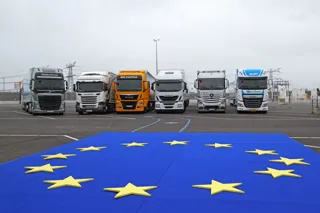Mercedes-Benz Trucks has concluded that there is no business case for truck platooning, saying that the technology failed to deliver appreciable fuel savings in its on-the-road tests.
Although the manufacturer will remain committed to ongoing platooning projects with partners, such as Ensemble in Europe, it now plans to refocus its resources on developing autonomous, self-driving technologies in its trucks.
It told delegates at this month’s Consumer Electronics Show (CES) in Las Vegas that results show fuel savings, even in perfect platooning conditions, were less than expected.
Savings were further diminished when the platoon was disconnected and the trucks had to accelerate to reconnect.
In at least four US long-distance applications, analysis showed no business case for driving platoons with new, aerodynamic trucks.
Mercedes has been involved in testing the technology, which enables trucks to drive in close formation by using advanced driver assistance systems, for several years, especially in the US.
That is particularly concerning for UK trials, given the expectation that the long, straight roads of the US would be ideally suited to the technology.
Congestion and the nature of the UK network have always been highlighted as possible barriers to it working effectively here.
Despite the conclusions drawn by Mer-cedes on the economic case for the technology after investing some €50 million (£44m) on platoon testing, the UK Government says trials here will proceed as planned.
A Department for Transport (DfT) spokesman said: “We remain fully committed to trialling lorry platooning and gathering an evidence base that will enable us to assess whether the technology is viable.”
The spokesman maintained that lorry platooning can mean “cheaper fuel bills for businesses, lower emissions and less congestion for other road users”.
The Government gave the green light for UK on-the-road trials in 2017 (commercialfleet.org, August 25, 2017).
DAF Trucks is providing three platoon-enabled trucks for the trial, which is being led by TRL (the Transport Research Laboratory).
On-the-road trials are expected to start in the spring, with DHL understood to be involved in live testing later this year.
TRL says it will be assessing the economic case closely in these trials, while trying to establish whether fuel spend and emissions can be cut as well as looking at the safety implications of truck platoons and its impact on other road users, traffic flow and network infrastructure.
The trial will run the trucks for 30,000 miles along the UK’s motorway network, with half of that distance used to run the trucks as a platoon and the other half as a comparator.
Fuel usage results will be eagerly awaited as commercial fleet operators try to establish whether platooning really has the potential to cut costs in the future.
Modest savings
Iveco UK alternative fuels director Martin Flach told last year’s Microlise conference: “The fuel consumption benefits from platooning will always be modest, maybe 5%, and then only for the truck in the middle of the platoon.
“But the real challenge is multi-brand platooning. You have to set up protocols that can be shared between truck manufacturers. And you need a mechanism for sharing the benefits between operators. The challenge should not be underestimated.”
Last year, the Ensemble consortium, which includes Europe’sbig six truck manufacturers – DAF, Daimler (Mercedes-Benz Trucks), Iveco, MAN, Scania and the Volvo Group – announced a three-year multi-brand truck platoon trial on European roads.
However, it will be year three before the project will focus on testing the multi-brand platoons on test tracks and international public roads, with a final Ensemble multi-brand truck platooning demonstration planned on public roads in 2021.
Daimler has confirmed its commitment to all ongoing platooning projects.
Martin Daum, CEO of Daimler Trucks and Buses, also said that truck platoons may yet prove to be viable if the need for drivers in the following trucks could be dispensed with.
Driverless trucks is now where the manufacturer intends to focus its resources. It announced at CES a commitment to invest €500m (£442m), creating more than 200 jobs, in its global push to bring highly automated trucks (Level 4) to the road within a decade.
Mercedes-Benz has decided to skip Level 3 autonomy, which requires more driver intervention, and go straight to Level 4, because it says Level 3 does not offer truck customers the corresponding benefits to compensate for the technology costs.
Instead, it sees Level 4, where no human interaction is involved, as having the potential to cut costs significantly.
However, going from Level 2 direct to Level 4 has its challenges. Despite all the similarities, the requirements for highly automated driving of cars and trucks also differ considerably from one another.
Higher demands
The sheer size of a truck makes higher demands on the technology than in the passenger car sector as do moving systems on an articulated system, for example.
In addition, the driving behaviour, due to a greater mass or other deceleration values as well as other driving characteristics, places much higher demands on the system.
The operating conditions in the transport industry are also much tougher.
However, it says technology from the Mercedes-Benz Cars division, which is suitable for haulers and their transport needs, will be used to develop its self-driving trucks.
“Highly automated trucks will improve safety, boost the performance of logistics and offer a great value proposition to our customers – and thus contribute considerably to a sustainable future of transportation,” concluded Daum.




















Winston - 04/02/2019 11:26
Platooning in the UK is, and always was, a non-starter. The DfT it seems, is continuing with costly trials. I predict it will be a waste of time and money!